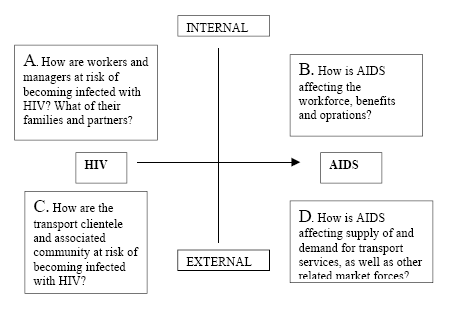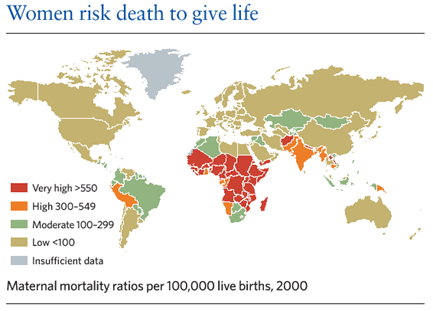|
|
Module 1: Why Gender and Transport?
1.3. Multi-Sectoral Issues
There are many important linkages between transport and other sectors.
Transport infrastructure and services provide access to basic services
such as health clinics, schools, markets, administrative offices as well
as agricultural extension, pension distribution points, banking and postal
facilities.
Access to Health
While the sector provides important physical access to health clinics
and hospitals through the provision of infrastructure and services,
it also has an important impact as a major vector for the spread of
HIV/AIDS.
Transport and HIV/AIDS
- Transport workers spend weeks and months away from their families
and many engage in risky sex behavior "on the road". When they return
to their homes, they can infect their wives and partners.
- Long haul truck drivers are the highest risk transport worker group.
- Gender norms shape attitudes towards sexuality, risk-taking, fidelity,
sharing information about sex, and power relations between men and
women. Thus, gender norms play a significant role in HIV/AIDS transmission.
- World Bank research has shown that the more unequal the relation
between men and women in a country, the higher its HIV prevalence
rate.*
*
Implications of AIDS for Transport
The HIV/AIDS epidemic has spread with ferocious speed. Virtually
unknown 20 years ago, AIDS is now the leading cause of death in
Africa. In several nations, life expectancy has dropped by over
10 years. By striking people young in their adulthood, HIV/AIDS
limits the pool of potential recruits and stops short the returns
in skilled labor the sector needs to be productive. Although the
number of studies on HIV prevalence may be few, the evidence is
clear; HIV prevalence is high among several cadres of transport
personnel. On the Dar-es-Salaam highway in 1996, HIV prevalence
was found to be 28 percent for truckers and 56 percent for their
female partners.
|
HIV/AIDS Prevention and Treatment
Transport policies, strategies, and communication campaigns need to address
HIV/AIDS prevention and treatment. Today, every World Bank transport project
in Africa uses HIV/AIDS clauses in the bidding documents to ensure that
access to information and prevention is given to workers. In addition,
several ministries have created HIV/AIDS policies and strategies for further
outreach and created effective partnerships with NGOs working on HIV/AIDS
issues.
Maternal Mortality
Every minute, around the world*:
-
110 women experience pregnancy-related complications
-
1 woman dies in child birth
| Many of these deaths
could be prevented by timely access to transport and
reduction of time and distance to health services |
How
can the transport sector help to reduce maternal mortality?
- Access to means of transport and passable roads can save the lives
of women in child birth and the lives of newborns.
- Women need to have access to emergency transport which is affordable
and available.
- Reliable health services need to be located closer to rural and
urban communities.
Access to Education
Without access to transport, labor consuming domestic tasks leave little
or no time for girls', youth's and women's education and skills training.
Intermediate means of transport (IMT) non-motorized transport (NMT), such
as traction animals, and non-transport low cost technology reduce women's
and girls' burden for collection of water and wood, leaving them time
for school. In addition, bicycles can enable girls to attend school and
reach school with less risk of gender based violence.
Gender and Transport Dimensions of the MDGs
Transport sector policies are increasingly focused on poverty reduction,
reaching the Millennium Development Goals (MDGs) as well as economic growth.
Poverty reduction and compensation strategies must be gender-sensitive
to ensure that they benefit the poor, particularly women.
|
Gender mainstreaming in the transport sector is essential to achieve the MDGs
|
click the links to show/hide details
The Millennium Development Goals (MDGs)
MDG 1: Eradicate Extreme Poverty and Hunger: Gender and Transport Dimensions
Goals:
-
Reduce by half the proportion of people living on less than a dollar a day.
-
Reduce by half the proportion of people who suffer from hunger.
Reality:
-
Poor access to transport by women and girls limits
productivity and income for their families and communities.
-
Lack of access to transport increases post-harvest losses.
-
Poor transport limits market and employment opportunities for males and females.
-
Road accidents affect the poor disproportionately, particularly women and children.
|
MDG 2: Universal Primary Education: Gender and Transport Dimensions
Goal:
-
Ensure that all boys and girls complete a full course of primary schooling.
Reality:
-
Girls help mothers transport water, fuel and food.
-
School girls often face gender violence on the way to and during school.
- Lack of transport affects girls and boys through
teacher absenteeism, lack of supervision and monitoring
of teachers which results in poor quality education.
|
MDG 3: Gender Equality: Transport Dimensions
Goal:
-
Eliminate gender disparity in primary and secondary education
preferably by 2005, and at all levels by 2015.
Reality:
-
Women and girls bear the burden of household tasks.
-
Little or no time for school, skill building or to acquire
the means to empower themselves.
-
Lack of public transport inhibits opportunity for girls in
particular, to attend secondary school.
|
MDG 4: Child Health
Goal:
-
Reduce by two thirds the mortality rate among children under five
Reality:
-
Lack of emergency transport for sick children.
-
Lack of transport for health equipment and medicines at
the health post resulting in poor quality health service.
- Constraints on access for health post users due to
distance, cost, difficult terrain, weather and rough
paths.
|
MDG 5: Maternal Mortality: Transport Dimensions
Goal:
-
Reduce by three quarters the maternal mortality ratio.
Reality:
-
Major factors are the delay of decision to transport
and lack of emergency transport.
- Constraints on access for health post users due to
distance, cost, difficult terrain, weather and rough
paths.
|
MDG
6: Combat HIV/AIDS, malaria and other diseases
Goal:
- Halt and begin to reduce the spread of HIV/AIDS.
- Halt and begin to reduce the incidence of malaria
and other major diseases.
Reality:
- The transport sector is a major vector for the spread
of HIV/AIDS.
- Women are particularly at risk.
- Poor engineering and attention to environmental impacts
can increase the opportunities for the spread of malaria
and other diseases.
|
MDG
7: Ensure environmental sustainability
Goal:
- Integrate the principles of sustainable development
into country policies and programmes; reverse loss of
environmental resources.
- Reduce by half the proportion of people without sustainable
access to safe drinking water.
- Achieve significant improvement in lives of at least
100 million slum dwellers, by 2020
Reality:
- Opportunities not often taken to maximize investments
in the sector such as access to water points through
drilling of wells, which could then be passed on to
communities for management and also would result in
the reduction of transport burdens for women and girls.
|
MDG
8: Develop a global partnership for development
Goal:
- Develop further an open trading and financial system
that is rule-based, predictable and non-discriminatory,
includes a commitment to good governance, development
and poverty reduction— nationally and internationally.
- Address the least developed countries' special needs.
This includes tariff- and quota-free access for their
exports; enhanced debt relief for heavily indebted poor
countries; cancellation of official bilateral debt;
and more generous official development assistance for
countries committed to poverty reduction.
- Address the special needs of landlocked and small
island developing States.
- Deal comprehensively with developing countries' debt
problems through national and international measures
to make debt sustainable in the long term.
- In cooperation with the developing countries, develop
decent and productive work for youth.
- In cooperation with pharmaceutical companies, provide
access to affordable essential drugs in developing countries.
- In cooperation with the private sector, make available
the benefits of new technologies— especially information
and communications technologies (ICTs)
.
Reality:
- Gender and youth targeting in labor-based works and
provision of opportunities for small and medium enterprises
working in the transport sector is not often a priority.
- There is a gender gap in access to the benefits of
ICTs.
|
|
|


